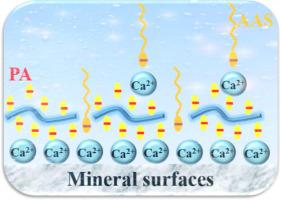Journal of Colloid and Interface Science ( IF 9.4 ) Pub Date : 2020-11-26 , DOI: 10.1016/j.jcis.2020.11.090 Zilong Liu , Pegah Hedayati , Murali K. Ghatkesar , Weichao Sun , Hayati Onay , Dirk Groenendijk , Johannes van Wunnik , Ernst J.R. Sudhölter

|
Surfactant losses by adsorption to rock surfaces make surfactant-based enhanced oil recovery economically less feasible. We investigated polyacrylate (PA) as a sacrificial agent in the reduction of anionic surfactant adsorption with focus on calcite surfaces by using quartz crystal microbalance with dissipation monitoring. It was found that the adsorption of the anionic surfactant alcohol alkoxy sulfate (AAS) followed a Langmuir adsorption isotherm, and the adsorbed amount reached saturation above its critical micellar concentration. Adsorption of PA was a much slower process compared to AAS adsorption. Increasing the calcium ion concentration also increased the amount of AAS adsorbed as well as the mass increase rate of PA adsorption. Experimental results combined with density functional theory calculations indicated that calcium cation bridging was important for anionic surfactant AAS and PA adsorption to calcite surfaces. To effectively reduce the amount of surfactant adsorption, it was needed to preflush with PA, rather than by a simultaneous injection. Preflushing with 30 ppm of PA gave a reduction of AAS adsorption of 30% under high salinity (HS, 31,800 ppm) conditions, compared to 8% reduction under low salinity (LS, 3180 ppm) conditions. In the absence of PA, the amount of adsorbed AAS was reduced by already 50% upon changing from HS to LS conditions. Lower calcium ion concentrations, as under LS conditions, contributed to this observation. On different mineral surfaces, PA reduced the AAS adsorption in the order of alumina > calcite > silica. These results offer important insights into mitigating surfactant adsorption using PA polyelectrolyte as sacrificial agent and contribute to improved flooding strategies with reduced surfactant loss.
中文翻译:

QCM-D研究以聚丙烯酸酯为牺牲剂减少阴离子表面活性剂的吸附
由于吸附到岩石表面上而导致的表面活性剂损失使基于表面活性剂的强化采油在经济上不可行。我们通过使用石英晶体微量天平和耗散监测技术,研究了聚丙烯酸酯(PA)作为牺牲剂,以减少方解石表面上阴离子表面活性剂的吸附为主要目标。发现阴离子表面活性剂醇烷氧基硫酸盐(AAS)的吸附遵循Langmuir吸附等温线,并且吸附量在其临界胶束浓度以上达到饱和。与AAS吸附相比,PA的吸附过程要慢得多。钙离子浓度的增加也增加了AAS的吸附量以及PA吸附的质量增加率。实验结果与密度泛函理论计算相结合表明,钙阳离子桥接对于阴离子表面活性剂AAS和PA吸附于方解石表面非常重要。为了有效减少表面活性剂的吸附量,需要使用PA进行预冲洗,而不是同时注入。在高盐度(HS,31,800 ppm)条件下,用30 ppm PA进行预冲洗可使AAS吸附量降低30%,而在低盐度(LS,3,180 ppm)条件下,AAS吸附量降低8%。在没有PA的情况下,从HS变为LS条件后,吸附的AAS量已经减少了50%。在LS条件下,较低的钙离子浓度有助于该观察。PA在不同的矿物表面上按氧化铝>方解石>二氧化硅的顺序减少了AAS的吸附。











































 京公网安备 11010802027423号
京公网安备 11010802027423号